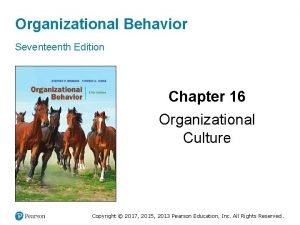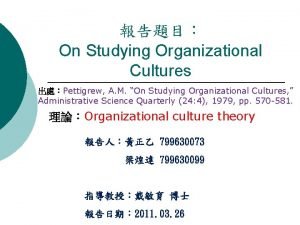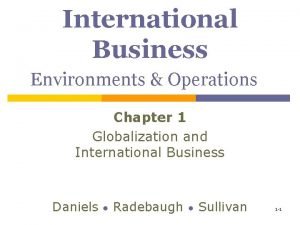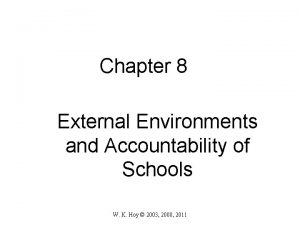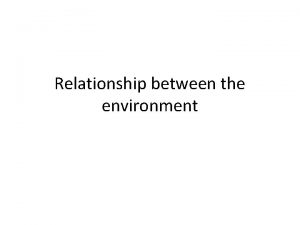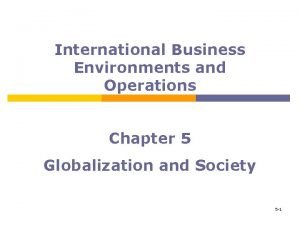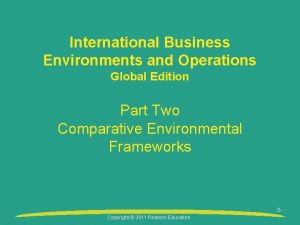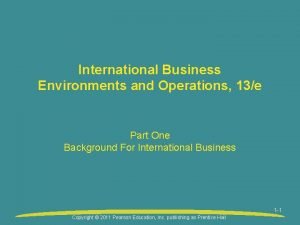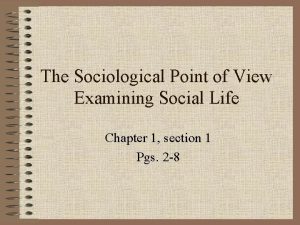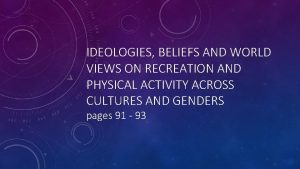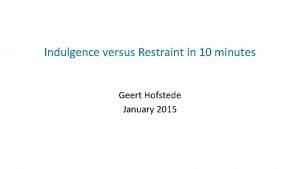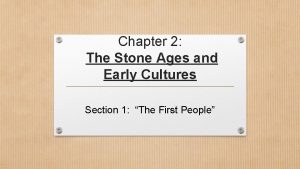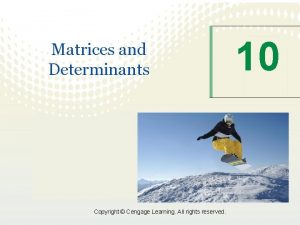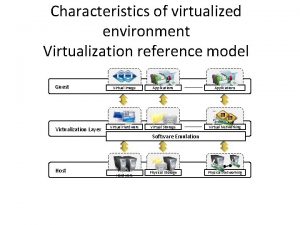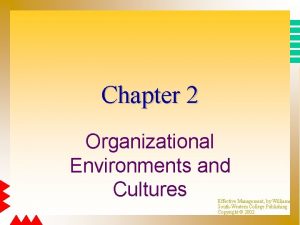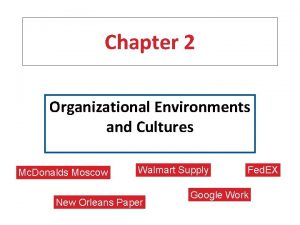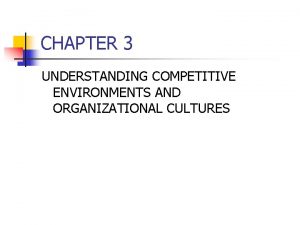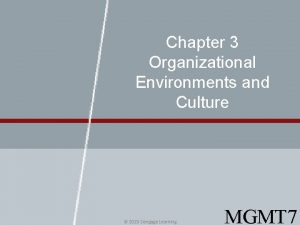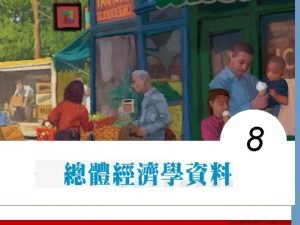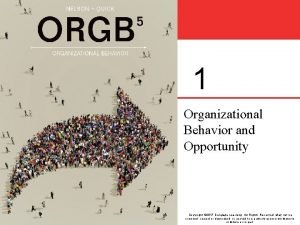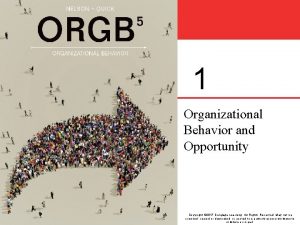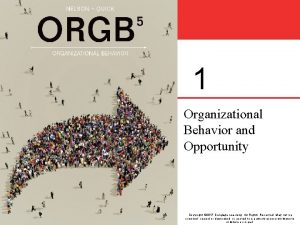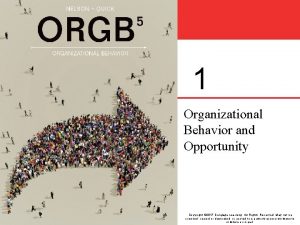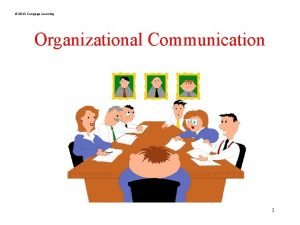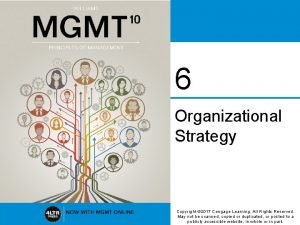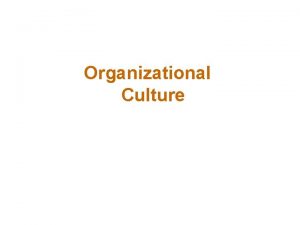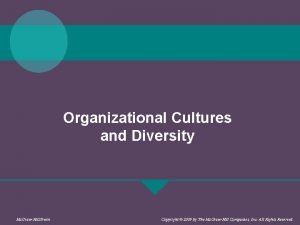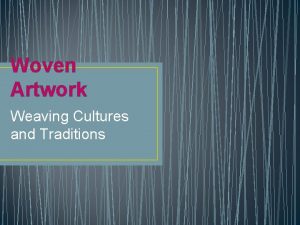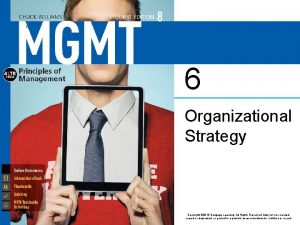3 Organizational Environments and Cultures Copyright 2017 Cengage
























- Slides: 24

3 Organizational Environments and Cultures Copyright © 2017 Cengage Learning. All Rights Reserved. May not be scanned, copied or duplicated, or posted to a publicly accessible website, in whole or in part.

LEARNING OUTCOMES 1. Discuss how changing environments affect organizations 2. Describe the four components of the general environment 3. Explain the five components of the specific environment 4. Describe the process that companies use to make sense of their changing environments 5. Explain how organizational cultures are created and how they can help companies be successful Copyright © 2017 Cengage Learning. All Rights Reserved. May not be scanned, copied or duplicated, or posted to a publicly accessible website, in whole or in part. MGMT 10 | CH 3 2

LO 1 Changing Environments • External environment: All events outside a company that can influence or affect it • Environmental change: Rate at which a company’s general and specific environments change • Stable environment: Rate of change is slow • Dynamic environment: Rate of change is fast Copyright © 2017 Cengage Learning. All Rights Reserved. May not be scanned, copied or duplicated, or posted to a publicly accessible website, in whole or in part. MGMT 10 | CH 3 3

LO 1 Punctuated Equilibrium Theory • Companies go through long periods of stability during which incremental changes occur • This is followed by short periods of dynamic, fundamental change, and then a new equilibrium Copyright © 2017 Cengage Learning. All Rights Reserved. May not be scanned, copied or duplicated, or posted to a publicly accessible website, in whole or in part. MGMT 10 | CH 3 4

LO 1 Environmental Complexity • Number and intensity of external factors in the environment that affect organizations • Simple environment: Includes few factors - Example - Diary industry • Complex environment: Includes many factors - Example - Personal computer (PC) business Copyright © 2017 Cengage Learning. All Rights Reserved. May not be scanned, copied or duplicated, or posted to a publicly accessible website, in whole or in part. MGMT 10 | CH 3 5

Resource Scarcity and Uncertainty LO 1 Resource scarcity • Abundance or shortage of critical organizational resources in an external environment Uncertainty • Extent to which managers can predict which external changes and trends will affect their businesses Copyright © 2017 Cengage Learning. All Rights Reserved. May not be scanned, copied or duplicated, or posted to a publicly accessible website, in whole or in part. MGMT 10 | CH 3 6

Exhibit 3. 1 Environmental Change, Environmental Complexity, and Resource Scarcity Copyright © 2017 Cengage Learning. All Rights Reserved. May not be scanned, copied or duplicated, or posted to a publicly accessible website, in whole or in part. LO 1 MGMT 10 | CH 3 7

Exhibit 3. 2 LO 2 General and Specific Environments Copyright © 2017 Cengage Learning. All Rights Reserved. May not be scanned, copied or duplicated, or posted to a publicly accessible website, in whole or in part. MGMT 10 | CH 3 8

LO 2 Economy • Growing economy provides a favorable environment for business growth • Consumers have more money to spend • Influences basic business decisions • Managers scan the economic environment by using economic statistics and business confidence indices - Show managers’ level of confidence about future business growth Copyright © 2017 Cengage Learning. All Rights Reserved. May not be scanned, copied or duplicated, or posted to a publicly accessible website, in whole or in part. MGMT 10 | CH 3 9

LO 2 Technology • Knowledge, tools, and techniques used to transform inputs into outputs • Technological changes help companies: • Provide better products • Produce products more efficiently • Must be used effectively to improve products or decrease costs Copyright © 2017 Cengage Learning. All Rights Reserved. May not be scanned, copied or duplicated, or posted to a publicly accessible website, in whole or in part. MGMT 10 | CH 3 10

Sociocultural Trends LO 2 • Demographic characteristics, general behavior, attitudes, and beliefs of people in a society • Changes in demographic characteristics affect how companies staff their businesses • Changes in behavior, attitudes, and beliefs affect the demand for a business’s products and services Copyright © 2017 Cengage Learning. All Rights Reserved. May not be scanned, copied or duplicated, or posted to a publicly accessible website, in whole or in part. MGMT 10 | CH 3 11

Political/Legal Component LO 2 • Business behavior is governed and regulated by: • Legislation • Regulations • Court decisions • Managers must be aware of the laws, regulations, and potential lawsuits that could affect their business Copyright © 2017 Cengage Learning. All Rights Reserved. May not be scanned, copied or duplicated, or posted to a publicly accessible website, in whole or in part. MGMT 10 | CH 3 12

Components of the Specific Environment LO 3 Customers • Purchase products and services Competitors • Firms in the same industry that sell similar products or services Suppliers • Companies that provide material, human, financial, and informational resources to other companies Copyright © 2017 Cengage Learning. All Rights Reserved. May not be scanned, copied or duplicated, or posted to a publicly accessible website, in whole or in part. MGMT 10 | CH 3 13

LO 3 Components of the Specific Environment (continued) Industry regulation • Regulations and rules that govern the practices and procedures of specific industries, businesses, and professions Advocacy groups • Concerned citizens who band together to try to influence the business practices of specific industries, businesses, and professions Copyright © 2017 Cengage Learning. All Rights Reserved. May not be scanned, copied or duplicated, or posted to a publicly accessible website, in whole or in part. MGMT 10 | CH 3 14

Making Sense of Changing Environments LO 4 • Environmental scanning • Searching the environment for important events or issues that might affect an organization • Interpreting environmental events • Viewed as either threats or opportunities • Deciding how to act on threats and opportunities • Use of cognitive maps to summarize perceived relationships Copyright © 2017 Cengage Learning. All Rights Reserved. May not be scanned, copied or duplicated, or posted to a publicly accessible website, in whole or in part. MGMT 10 | CH 3 15

LO 5 Internal Environment • Events and trends inside an organization that affect management, employees, and organizational culture • Organizational culture: Values, beliefs, and attitudes shared by organizational members Copyright © 2017 Cengage Learning. All Rights Reserved. May not be scanned, copied or duplicated, or posted to a publicly accessible website, in whole or in part. MGMT 10 | CH 3 16

Creation and Maintenance of Organizational LO 5 Cultures • Company founders create organizations in their images and imprint them with their beliefs, attitudes, and values • Organizational stories: Help make sense of organizational events • Emphasize culturally consistent assumptions, decisions, and actions • Organizational heroes: People admired for their qualities and achievements within the organization Copyright © 2017 Cengage Learning. All Rights Reserved. May not be scanned, copied or duplicated, or posted to a publicly accessible website, in whole or in part. MGMT 10 | CH 3 17

Exhibit 3. 4 LO 5 Keys to an Organizational Culture That Fosters Success Copyright © 2017 Cengage Learning. All Rights Reserved. May not be scanned, copied or duplicated, or posted to a publicly accessible website, in whole or in part. MGMT 10 | CH 3 18

Changing Organizational Cultures LO 5 Behavioral addition • Having managers and employees perform new behaviors that are central to and symbolic of the desired organizational culture Behavioral substitution • Having managers and employees perform new behaviors central to the new organizational culture in place of behaviors that were central to the old culture Copyright © 2017 Cengage Learning. All Rights Reserved. May not be scanned, copied or duplicated, or posted to a publicly accessible website, in whole or in part. MGMT 10 | CH 3 19

LO 5 Changing Organizational Cultures (continued) • Changing visible artifacts • Visible signs of an organization’s culture - Include office design and layout, company dress code, and company benefits and perks • Employee selection • Selecting those who have values and beliefs consistent with the desired culture Copyright © 2017 Cengage Learning. All Rights Reserved. May not be scanned, copied or duplicated, or posted to a publicly accessible website, in whole or in part. MGMT 10 | CH 3 20

KEY TERMS • • • External environments Environmental change Stable environment Dynamic environment Punctuated equilibrium theory Environmental complexity Simple environment Complex environment Resource scarcity • • • Uncertainty General environment Specific environment Business confidence indices Technology Competitors Competitive analysis Supplier dependence Copyright © 2017 Cengage Learning. All Rights Reserved. May not be scanned, copied or duplicated, or posted to a publicly accessible website, in whole or in part. MGMT 10 | CH 3 21

KEY TERMS • • • Buyer dependence Opportunistic behavior Relationship behavior Industry regulation Advocacy groups Public communications Media advocacy Product boycott Environmental scanning Cognitive maps Internal environment Organizational culture Organizational stories Organizational heroes Company mission Consistent organizational culture • Behavioral addition • Behavioral substitution • Visible artifacts • • • Copyright © 2017 Cengage Learning. All Rights Reserved. May not be scanned, copied or duplicated, or posted to a publicly accessible website, in whole or in part. MGMT 10 | CH 3 22

SUMMARY • Changing environments affect a firm’s decisions and performance • General environment consists of the economy, technological, sociocultural, and political/legal trends • Specific environment comprises customer, competitor, supplier, industry regulation, and advocacy groups • Adaptability, involvement, clear mission, and consistency influence successful cultures Copyright © 2017 Cengage Learning. All Rights Reserved. May not be scanned, copied or duplicated, or posted to a publicly accessible website, in whole or in part. MGMT 10 | CH 3 23

Copyright © 2017 Cengage Learning. All Rights Reserved. May not be scanned, copied or duplicated, or posted to a publicly accessible website, in whole or in part. MGMT 10 | CH 3 24
 Spiritual organization
Spiritual organization Cengage chapter 7
Cengage chapter 7 Edgar schein 3 levels of culture
Edgar schein 3 levels of culture Copyright secondary sara (2017) answers
Copyright secondary sara (2017) answers International business: environments & operations
International business: environments & operations External environments and accountability of schools ppt
External environments and accountability of schools ppt Simple reflex agents examples
Simple reflex agents examples Relationship between micro macro and market environment
Relationship between micro macro and market environment International business chapter 5
International business chapter 5 International business environments and operations
International business environments and operations Exercise in hot and cold environments
Exercise in hot and cold environments International business environments and operations
International business environments and operations The comparative study of past and present cultures
The comparative study of past and present cultures Recreational activities across cultures and genders
Recreational activities across cultures and genders Chapter 20:2 obtaining and handling cultures
Chapter 20:2 obtaining and handling cultures Indulgence versus restraint hofstede
Indulgence versus restraint hofstede Atakapans
Atakapans What impact did nearness to the sea have on greece
What impact did nearness to the sea have on greece Cultures and organizations software of the mind
Cultures and organizations software of the mind School of languages cultures and societies
School of languages cultures and societies The stone ages and early cultures
The stone ages and early cultures Sequence and series cengage
Sequence and series cengage Matrices formula
Matrices formula Cengage anatomy and physiology
Cengage anatomy and physiology Reference model of full virtualization
Reference model of full virtualization
